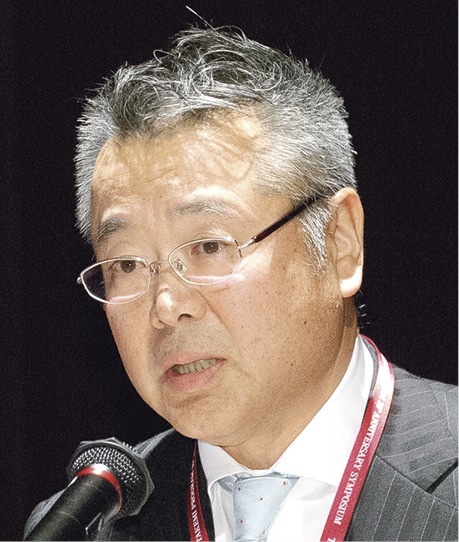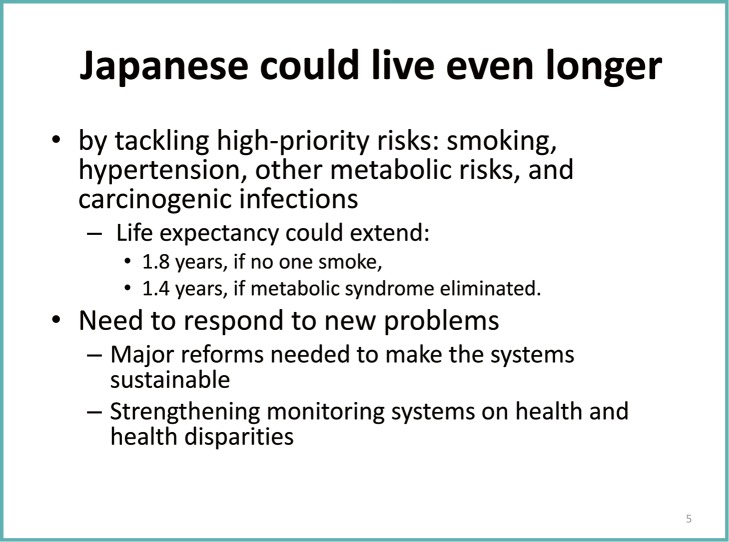I was a Takemi Fellow in 2006-2007 and subsequently remained at Harvard University under another fellowship for nearly two years. The Takemi Program has determined the direction of my work for many years.
My opinion is similar to that of Dr. Jimba and Dr. Nakamura. The health of the Japanese people has been built by the marvelous national policy of universal health coverage and its embodiment in community medicine. This presentation explains, using available data, the factors behind Japan’s achievement of excellent health following the realization of universal health coverage.
Japanese women nowadays have the longest healthy life expectancy in the world. This status was achieved in the late 1980s marking major improvement from the early post-World War II era, when Japanese women had a life expectancy of only 55 years. In this process of rapid progress, Japan overtook leading countries in the world, and has been the top runner ever since it attained this position. Japanese men have also been showing similar trends.
How has this been possible? This leads us to question what determines health. Although there are known risk factors related to genetics and aging, it has been shown that there are no special genes conferring long life on the Japanese. The next thing to consider is the difference in lifestyle factors, such as eating, exercise, and smoking. These, in turn, are affected by “upstream” social factors, such as poverty, living environment, and human connections. At a further upstream level, all these factors are regulated by national policies including universal health coverage. The area of my work relates to the extent to which these kinds of social factors affect health. What, as a practical matter, has made the Japanese so healthy? Using objective data to the extent possible, I will describe the transitions in health status in postwar Japan, dividing the period into three phases. Thereafter, I will try to answer the questions: what health challenges are we facing today and how should we resolve those challenges (Slide 1)?
(Slide 1).
Postwar reconstruction and rapid economic growth began around 1950. This was also the time when so-called mammoth housing complexes started to appear across the country. Japan enacted many health-related laws in this period. For example, the government promoted preventive strategies such as spreading the use of X-ray exams. Tuberculosis treatment became free in 1951 and universal health coverage was achieved in 1961. However, a system does not work just because it is there. Community residents, physicians, and healthcare personnel worked together as bearers of the new system, supporting initiatives such as health checkups. This resulted, for example, in the rapid rise of women giving birth in hospitals and midwifery centers, and the hygienic environment also improved considerably. What prominently contributed to the growth in life expectancy during this period was the reduction in mortality from tuberculosis among adults. Analysis has shown that this increased the life expectancy of women by two or more years. The reduction in infant mortality from infectious diseases also added two to three years onto life expectancy. The same trends were also seen in men.
From 1965 onward, rapid economic growth continued and medical costs increased. After a certain degree of success was achieved in infectious disease control, chronic diseases emerged as a major problem in this period. Particularly in the case of Japan, death from stroke in association with salty food was a very serious problem that was pushing medical costs up. The policy the national government took in response was to expand insurance coverage to preventive medications such as antihypertensive drugs. That enabled doctors to provide preventive care. Furthermore, residents, physicians, and public health center personnel have joined hands and continued to conduct health education and awareness building to restrict salt intake. Health check-ups were also made compulsory. As a result, the incidence of stroke declined at a surprising speed from 1965 forward, nearly reaching the same level as developed countries. In relation to life span, the decrease in mortality from stroke in adults (aged 15 and older) added four to five years onto life expectancy. Similar results were also seen in men.
What I want to emphasize here is that while disease incidence rates clearly decreased with the development of legislation, this achievement depended on human resources in the community. Were it not for well-established fundamental community health services that embraced the national system, Japanese people would not have achieved long life expectancies. In other words, communities in the country had what they needed for success. In this way, improvement of health was achieved through the ideal combination of top-down and bottom-up approaches.
From the 1980s onward, the life expectancy in Japan has retained the top position in the world and still continued to increase despite the pressing need to curb healthcare cost in the time of hardship. This persistent trend may also be attributable to the historical development of fundamental community health services.
Lastly, let us consider current health policy issues. With respect to direct risks, smoking and hypertension are the most important risk factors raising mortality (Slide 2). It is estimated that overcoming smoking and hypertension would reduce Japanese mortality by more than 200,000 people per year. The aging of the population and the prevention of the need for nursing care are problems that must also be considered when aiming to resolves these issues (Slides 3, 4). Moreover, there is the problem of so-called health disparities, which has become a concern in recent years. Because Japan’s social security system, including universal health coverage, is designed on the premise that the household is the basic unit of society, it is no longer able to subsume all members of society well, as a result of the diversification of lifestyles. Nowadays, there are people who do not fit perfectly into the system. Examples include single-parent households, the problem of non-regular employment, and young adult men who are isolated from local society. A challenge from here on will be to establish new safety nets that can accommodate the diversification of lifestyles.
(Slide 2).
(Slide 3).
(Slide 4).
Last year the Ministry of Health, Labour and Welfare raised the reduction of health disparities as a goal of the second Healthy Japan 21 campaign. Now we need to consider how we can actually achieve that goal.
As seen above, there are many challenges. If we were to resolve these challenges, it would mean healthier and longer lives for the Japanese people. It has been calculated that resolving smoking and metabolic risk factors could add another three or more years to life expectancy. In what kind of people within society do these risk factors accumulate? Who should be the targets for countermeasures? We need to answer these questions (Slide 5).
(Slide 5).
We therefore have to promote transparency. More specifically, we need to make the most effective use of the existing data to build an information base for deciding who is at risk and who should be prioritized in the allocation of limited resources. This kind of persistent reform will be integral to the perpetuation of an equitable public healthcare system, which is the pride of Japan.
Comment

Yoshihiko KUBOTA2
I would like to comment based on things I feel in the course of my everyday practice. We just heard from Dr. Kondo that the universal health coverage system allows equal access to medical care and that medical progress has made Japan into a country where the people enjoy high rates of longevity. However, there is also a tendency for physicians to concentrate in hospitals in big cities that have advanced medical technology and equipment. In particular, the shortage of doctors in rural hospitals is a problem. The shortage of doctors in Yamanashi Prefecture where I live, especially in the remote areas, is very serious. Under the new post-graduate clinical internship system, young interns leave for more attractive hospitals outside the prefecture, causing a loss of young physicians. The University of Yamanashi cannot dispatch physicians to local hospitals, and so no one is sent to work with us physicians at remote hospitals. I feel that these medical disparities are getting worse, since in actuality people cannot receive the medical care that they need. Local physicians such as me, serving as family doctors, are also getting older now. We doctors in private practice also have to handle emergency cases, and so I feel that it would be good if the Japan Medical Association were to dispatch physicians and provide support.
I live in Minamikoma, a mountainous area in Yamanashi Prefecture. I would like to speak about an initiative in which our medical association is engaged. The aging of society is occurring throughout the country. As of April 1, 2013, the percentage of senior citizens aged 65 and older was 24.7% nationwide and 25.7% in Yamanashi Prefecture. In Minamikoma County where I live, it is very high at 34.8%. This situation would be fine so long as elderly people were in good health, but the number of elderly people living alone at home, confined to bed, or living with dementia is increasing year by year. In response, the medical association in Minamikoma launched the Kyonan Area At-Home Medical Care Assistance Center with the cooperation of hospital doctors and doctors in private practice with the aim of supporting healthcare. When a person comes to need at-home care, we assign an attending physician or a deputy attending physician and cooperating physicians in different specialties. We also make arrangements such as searching for a most appropriate hospital when a patient needs to be hospitalized. Now we are studying of adopting an IT-based health management system that will enable the sharing of information with dentists, nurses, pharmacists, care managers, and helpers. We have started preparatory work, and are considering of sharing information on individuals with everyone in this way.
If Japan is to maintain its position as a country of good health and longevity in the future, we must ensure that specialists are able to keep track of the condition of every person and provide finely tuned medical care.
| 2 Yamanashi Medical Association, Yamanashi, Japan. Member of the JMA Global Health Committee. |
Footnotes
*1 This article is a revised transcript of the presentation delivered by the author at the Takemi Program 30th Anniversary Symposium, which was held at the JMA Auditorium, Tokyo, on November 23, 2013.
Due to space limitations, not all of the slides shown in the original presentation appear in this article.








